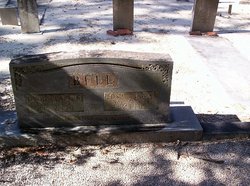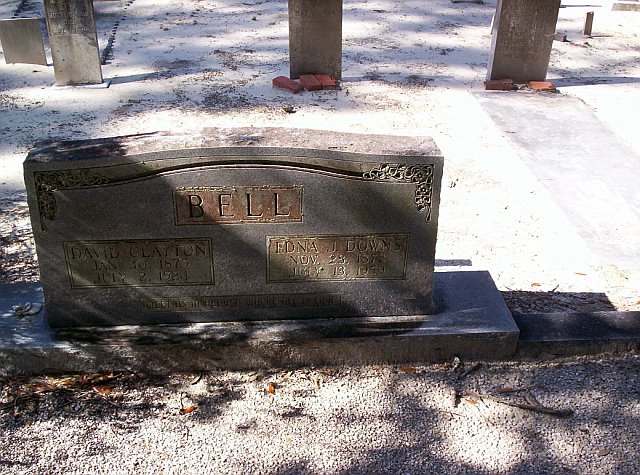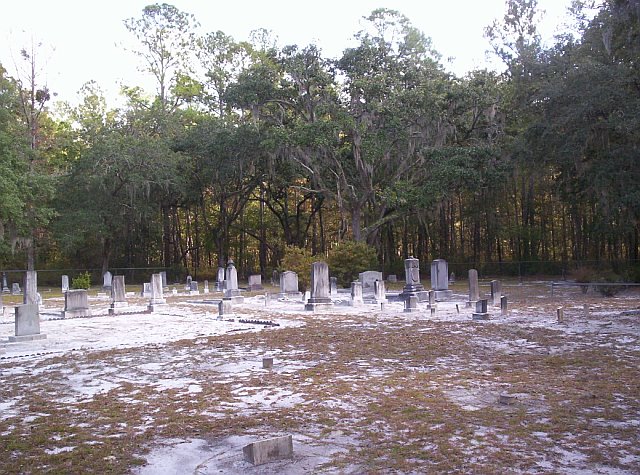His World War I draft card, filled out in September of 1918, lists him as a farmer with grey eyes and black hair and of medium height. While every census lists him as a farmer, he did not like to farm and sought out alternatives. Clayton worked at a sawmill and later ran a general store and post office. He died of pernicious anemia July 2, 1924 in a hospital in Savannah, Chatham County, Georgia at age 49. His sons donated blood in an effort to save him through transfusions, but this was before full knowledge of blood types and before blood banks. Clayton is buried in Little Creek Cemetery in Bryan County next to his beloved wife Edna. Family tradition says he asked to be buried only three, not six, feet down. There is a family mystery about what happened to photos of Clayton. I hope one of his descendants will add his photo to this site. Clayton's ancestry was English, Welsh, and--through the Bell surname--Native American (Lumbee).
There are a variety of reasons Native American (American Indian) ancestry may not show up in a person's DNA. One obvious reason is that a person may never have had any Native American ancestors. There are, however, other reasons. For most Americans with Native American ancestors, that ancestry is five or more generations back. In fact it can be so far back in a family tree that it does not show up in DNA tests. Also, most ancestry testing companies use only a small sample of Native American groups (often less than half a dozen tribes) as a reference for testing, and many of those sample groups are from South, rather than North, America. (My own case is a good example of how inaccurate genetics testing companies can be when it comes to Native American ancestry. Three different companies have estimated my Indian ancestry as none, a trace, and 9%.) Another important point about Native American DNA ancestry should be made. Anthropologist Mary Helms created the term "colonial Indian tribes" in the 1960s to refer to societies which originated as recognizable entities only as a direct result of colonial policies. Colonial tribes are often a racially mixed people that over time became identified more with their Indian ancestry rather than their African or white ancestry. These groups are culturally Indian while ultimately having little, if any, Indian DNA. Colonial tribes include groups as diverse as the Miskito Indians of eastern Nicaragua (whom Helms studied); various Amazon tribes in Brazil; the Lumbee Indians of North Carolina; the Black Seminoles of Oklahoma, Mexico, and the Bahamas; and many others. The term colonial tribe attempts to get at the idea that someone can be culturally something (Native American, for example) without being biologically something. So, for all of the above reasons, it should not be surprising that someone with, for example, a Lumbee Indian ancestor would not necessarily test as having significant or any Native American DNA.
Thanks so much to Nevada McClelland Bell and Bell and Downs family researchers for much of this information. Any errors, however, are mine alone. Please go to the "edit" link on this site with any corrections or additions.
His World War I draft card, filled out in September of 1918, lists him as a farmer with grey eyes and black hair and of medium height. While every census lists him as a farmer, he did not like to farm and sought out alternatives. Clayton worked at a sawmill and later ran a general store and post office. He died of pernicious anemia July 2, 1924 in a hospital in Savannah, Chatham County, Georgia at age 49. His sons donated blood in an effort to save him through transfusions, but this was before full knowledge of blood types and before blood banks. Clayton is buried in Little Creek Cemetery in Bryan County next to his beloved wife Edna. Family tradition says he asked to be buried only three, not six, feet down. There is a family mystery about what happened to photos of Clayton. I hope one of his descendants will add his photo to this site. Clayton's ancestry was English, Welsh, and--through the Bell surname--Native American (Lumbee).
There are a variety of reasons Native American (American Indian) ancestry may not show up in a person's DNA. One obvious reason is that a person may never have had any Native American ancestors. There are, however, other reasons. For most Americans with Native American ancestors, that ancestry is five or more generations back. In fact it can be so far back in a family tree that it does not show up in DNA tests. Also, most ancestry testing companies use only a small sample of Native American groups (often less than half a dozen tribes) as a reference for testing, and many of those sample groups are from South, rather than North, America. (My own case is a good example of how inaccurate genetics testing companies can be when it comes to Native American ancestry. Three different companies have estimated my Indian ancestry as none, a trace, and 9%.) Another important point about Native American DNA ancestry should be made. Anthropologist Mary Helms created the term "colonial Indian tribes" in the 1960s to refer to societies which originated as recognizable entities only as a direct result of colonial policies. Colonial tribes are often a racially mixed people that over time became identified more with their Indian ancestry rather than their African or white ancestry. These groups are culturally Indian while ultimately having little, if any, Indian DNA. Colonial tribes include groups as diverse as the Miskito Indians of eastern Nicaragua (whom Helms studied); various Amazon tribes in Brazil; the Lumbee Indians of North Carolina; the Black Seminoles of Oklahoma, Mexico, and the Bahamas; and many others. The term colonial tribe attempts to get at the idea that someone can be culturally something (Native American, for example) without being biologically something. So, for all of the above reasons, it should not be surprising that someone with, for example, a Lumbee Indian ancestor would not necessarily test as having significant or any Native American DNA.
Thanks so much to Nevada McClelland Bell and Bell and Downs family researchers for much of this information. Any errors, however, are mine alone. Please go to the "edit" link on this site with any corrections or additions.
Inscription
"Meet us in heaven where all is love."
Family Members
-
![]()
Marvin Barnard Bell
1897–1940
-
![]()
Birdie Mae Bell Roberts
1899–1975
-
![]()
Ruby Robena Bell McClelland
1901–1975
-
![]()
James Roy Bell Sr
1904–1969
-
![]()
Robert Travis Bell
1907–1907
-
![]()
Lester Wyley Bell
1908–1987
-
![]()
Willie Oscar Bell
1911–1989
-
![]()
Lois Netherae Bell Peyton
1913–2005
-
![]()
Mary Irene Bell Smith
1916–1995
-
![]()
Edna Josephine "Jo" Bell Deal
1921–2014
-
![]()
David Clayton Bell Jr
1923–1966





























